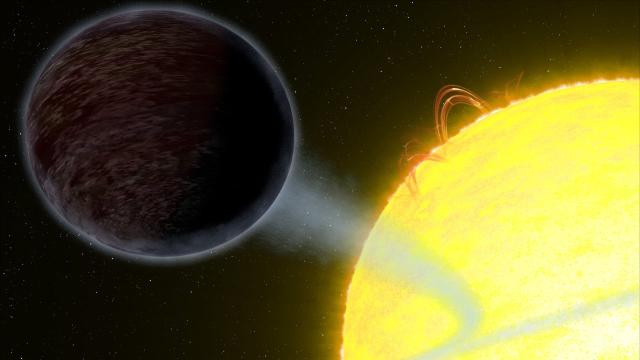Over a thousand light years away, there’s a planet that isn’t conforming to your so-called rules. It isn’t one of the jocks like Earth, or one of the preps like Saturn. WASP-12b probably sits beneath the bleachers dressed in its black outfit with the checkered wristbands it bought from Hot Jupiter Topic, listening to The Cure while making pentagram stick-and-pokes and discussing the inevitability of the Universe’s heat death.
Image: NASA, ESA and G. Bacon (STScI)
Scientists discovered WASP-12b back in 2008 with the SuperWASP-N camera in the Canary Islands, but probably didn’t realise what kind of a rebellious child they’d ended up with. After watching it orbit its parent star, WASP-12a, scientists realised that the planet reflected very little light; it’s as dark as the Dark Lord.
The scientists observed WASP-12b because they were interested in its atmosphere, and planned to measure the light reflecting off of it as it passed behind its relatively dim parent star. WASP-12b is already a highly-studied planet, according to a Hubble release. The planet has a radius twice Jupiter’s and is incredibly close to WASP-12a, with a year lasting around a single Earth day. Its 2600C surface stretches like an egg from its nearby sun. If there’s one thing that’s certain, this planet isn’t a freaking poser.
Dimensions aside, the planet reflects at most 6.4 per cent of the light that hits it. This is like black paint, or my lipstick at a Taking Back Sunday concert, and for comparison, the darkest object in our solar system is probably a comet that reflects three or so per cent of incoming light. Darker planets have been found; scientists found one that reflects only one per cent of the light back in 2011, for example. They felt their observations were consistent with a planet made mostly from hydrogen and helium, making it look more like a star than a planet.
The scientists measured the planet’s reflectivity down to the specific colour, which has only been done for one other planet, according to the paper submitted to the Astrophysical Journal. They found that WASP-12b doesn’t seem to show a colour preference in the light it reflects, but glows red from its heat. This, they report, is very different from the other planet, HD 189733b, which seemed to reflect more light closer to the blue end of the spectrum. These stark differences demonstrated to the scientists that there’s a lot of diversity within these Hot Jupiters, and a lot to learn based on the light they reflect. Welcome to Hot Jupiter High.
Things will be ok, WASP-12b, and maybe one day you’ll look back and say it was all just a phase. But until then, chaos reigns.
